Milk is a staple beverage and ingredient that is enjoyed by people all over the world.
It is used to make various dairy products, from cheese to yogurt to butter, and it can be enjoyed alone as a drink or mixed with other ingredients to create tasty beverages and dishes. Many people consume store-bought milk, which is sold in grocery stores and supermarkets, as a convenient and affordable option. But what exactly is in store-bought milk? Let’s take a closer look.
Whole Milk
Whole milk is the most commonly consumed type of milk. It is also one of the most nutritious types, as it contains a significant amount of calcium, vitamin D, and other essential nutrients. The ingredients in whole milk typically include:.
- Milk from cows, goats, or sheep (depending on the source)
- Vitamin D (added for extra nutrition)
Some brands of whole milk may also contain added sugars or artificial flavors to enhance the taste. However, many health experts recommend consuming plain, unsweetened whole milk for optimal nutrition.
Low-Fat Milk
Low-fat milk is another popular option for those seeking a lighter alternative to whole milk. It typically contains less fat than whole milk, and may also be lower in calories and cholesterol. The ingredients in low-fat milk typically include:.
- Milk from cows, goats, or sheep (depending on the source)
- Skim milk powder (added to thicken the milk)
- Vitamin A and D (added for extra nutrition)
Some brands of low-fat milk may also contain added sugars or artificial flavors to enhance the taste. However, many health experts recommend consuming plain, unsweetened low-fat milk for optimal nutrition.
Skim Milk
Skim milk is another popular option for those seeking a low-fat, low-calorie alternative to whole milk. It typically contains no more than 0.5% fat, making it a good choice for individuals who are watching their weight or cholesterol levels.
The ingredients in skim milk typically include:.
- Milk from cows, goats, or sheep (depending on the source)
- Non-fat milk solids (added to thicken the milk)
- Vitamin A and D (added for extra nutrition)
Like low-fat milk, some brands of skim milk may also contain added sugars or artificial flavors to enhance the taste. However, many health experts recommend consuming plain, unsweetened skim milk for optimal nutrition.
Flavored Milk
Flavored milk is a popular option for those who enjoy a sweeter taste. It typically contains added sugars and artificial flavors, which can add significant calories and reduce the overall nutritional value of the milk.
The ingredients in flavored milk typically include:.
- Milk from cows, goats, or sheep (depending on the source)
- Sugar (added for sweetness)
- Artificial flavors (added to enhance the taste)
- Colorings (added for aesthetic appeal)
- Vitamin A and D (added for extra nutrition)
While flavored milk can be a tasty treat, it is important to consume it in moderation due to its high sugar content.
Lactose-Free Milk
For individuals who are lactose intolerant, lactose-free milk can be a good alternative. It typically contains the same basic ingredients as regular milk, but has had the lactose removed or reduced through a special enzyme treatment.
The ingredients in lactose-free milk typically include:.
- Milk from cows, goats, or sheep (depending on the source)
- Lactase enzyme (added to break down lactose)
- Vitamin A and D (added for extra nutrition)
Lactose-free milk can be a good option for individuals who have trouble digesting lactose, but it may still contain the same amount of fat and calories as regular milk.
Oat Milk
Oat milk is a newer, plant-based milk alternative that has gained popularity in recent years. It is made from oats and water, and may also contain additional ingredients such as oil or natural flavors. The ingredients in oat milk typically include:.
- Oats (main ingredient)
- Water (used to blend the oats into a liquid form)
- Oil (added to give the milk a creamier texture)
- Natural flavors (added to enhance the taste)
- Other ingredients, depending on the brand (such as vitamins or stabilizers)
Oat milk is a good option for individuals who are allergic to dairy or are following a plant-based diet, but it may also contain added sugars and be lower in protein than regular milk.
Soy Milk
Soy milk is another popular plant-based milk alternative that is made from soybeans. It is often used in cooking and baking, and can also be consumed as a beverage. The ingredients in soy milk typically include:.
- Soybeans (main ingredient)
- Water (used to blend the soybeans into a liquid form)
- Sugar (added for sweetness)
- Artificial flavors (added to enhance the taste)
- Colorings (added for aesthetic appeal)
- Other ingredients, depending on the brand (such as vitamins or stabilizers)
Soy milk is a good option for individuals who are allergic to dairy or are following a plant-based diet, but it may also contain added sugars and be lower in calcium than regular milk.
Almond Milk
Almond milk is a popular plant-based milk alternative that is made from almonds and water. It is often used in cooking and baking, and can also be consumed as a beverage. The ingredients in almond milk typically include:.
- Almonds (main ingredient)
- Water (used to blend the almonds into a liquid form)
- Sugar (added for sweetness)
- Artificial flavors (added to enhance the taste)
- Colorings (added for aesthetic appeal)
- Other ingredients, depending on the brand (such as vitamins or stabilizers)
Almond milk is a good option for individuals who are allergic to dairy or are following a plant-based diet, but it may also contain added sugars and be lower in protein than regular milk.
Rice Milk
Rice milk is another plant-based milk alternative that is made from rice and water. It is often used in cooking and baking, and can also be consumed as a beverage. The ingredients in rice milk typically include:.
- Rice (main ingredient)
- Water (used to blend the rice into a liquid form)
- Sugar (added for sweetness)
- Artificial flavors (added to enhance the taste)
- Colorings (added for aesthetic appeal)
- Other ingredients, depending on the brand (such as vitamins or stabilizers)
Rice milk is a good option for individuals who are allergic to dairy or are following a plant-based diet, but it may also contain added sugars and be lower in protein than regular milk.
Conclusion
In conclusion, store-bought milk can contain a variety of ingredients depending on the type and brand. While whole milk is generally the most nutritious option, individuals who are watching their weight or cholesterol may prefer low-fat or skim milk.
Those who are lactose intolerant or following a plant-based diet can choose from a variety of plant-based milk alternatives, such as oat milk, soy milk, almond milk, and rice milk. However, it is important to read the labels and choose milk that is unsweetened or low in added sugars to support optimal health.



























